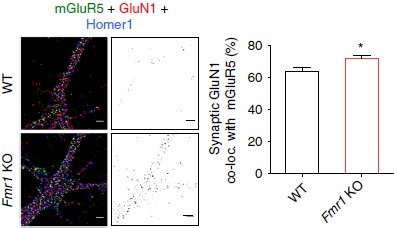Overview
- Peptide ETEKPRGYQMSTRLK(C), corresponding to amino acid residues 385-399 of rat NMDA receptor 1 (Accession P35439). Extracellular, N-terminus.
- Rat brain lysate (1:400 - 1:600).
 Western blot analysis of rat brain lysate:1. Anti-NMDAR1 (GluN1) (extracellular) Antibody (#AGC-001), (1:600).
Western blot analysis of rat brain lysate:1. Anti-NMDAR1 (GluN1) (extracellular) Antibody (#AGC-001), (1:600).
2. Anti-NMDAR1 (GluN1) (extracellular) Antibody, preincubated with NMDAR1/GluN1 (extracellular) Blocking Peptide (#BLP-GC001).
- Mouse hippocampus.
- Live intact rat hippocampal neurons (1:300). See Mikasova, L. et al. (2012) Brain 135, 1606.
The NMDA receptors are members of the glutamate receptor family of ion channels that also include the AMPA and Kainate receptors.
The NMDA receptors are encoded by seven genes: one NMDAR1 (or NR1) subunit, four NR2 (NR2A-NR2D) and two NR3 (NR3A-NR3B) subunits. The functional NMDA receptor appears to be a heterotetramer composed of two NMDAR1 and two NMDAR2 subunits. Whereas the NMDAR2 subunits that assemble with the NMDAR1 subunit can be either of the same kind (i.e. two NMDAR2A subunits) or different (one NMDAR2A with one NMDAR2B). NMDAR3 subunits can substitute the NMDAR2 subunits in their complex with the NMDAR1 subunit.
The NMDAR is unique among ligand-gated ion channels in that it requires the simultaneous binding of two obligatory agonists: glycine and glutamate that bind to the NMDAR1 and NMDAR2 binding sites respectively. Another unique characteristic of the NMDA receptors is their dependence on membrane potential. At resting membrane potentials the channels are blocked by extracellular Mg2+. Neuronal depolarization relieves the Mg2+ blockage and allows ion influx into the cells. NMDA receptors are strongly selective for Ca2+ influx differing from the other glutamate receptor ion channels that are non-selective cation channels.
Ca2+ entry through the NMDAR regulates numerous downstream signaling pathways including long term potentiation (a molecular model of memory) and synaptic plasticity that may underlie learning. In addition, the NMDA receptors have been implicated in a variety of neurological disorders including epilepsy, ischemic brain damage, Parkinson’s and Alzheimer’s disease.
NMDA receptors expression and function are modulated by a variety of factors including receptor trafficking to the synapses and internalization as well as phosphorylation and interaction with other intracellular proteins.
Application key:
Species reactivity key:
 Increased Synaptic GluN1/mGluR5/Homer1 in Fmr1-/- Mice.Immunocytochemical staining of mouse hippocampal neurons using Anti-NMDAR1 (GluN1) (extracellular) Antibody (#AGC-001), (red). Triple immunostaining experiment indicates increased synaptic clustering of GluN1, mGluR5 and Homer1 in Fmr1 knockout mice.Adapted from Aloisi, E. et al. (2017) Nat. Commun. 8, 1103. with permission of SPRINGER NATURE.
Increased Synaptic GluN1/mGluR5/Homer1 in Fmr1-/- Mice.Immunocytochemical staining of mouse hippocampal neurons using Anti-NMDAR1 (GluN1) (extracellular) Antibody (#AGC-001), (red). Triple immunostaining experiment indicates increased synaptic clustering of GluN1, mGluR5 and Homer1 in Fmr1 knockout mice.Adapted from Aloisi, E. et al. (2017) Nat. Commun. 8, 1103. with permission of SPRINGER NATURE.

